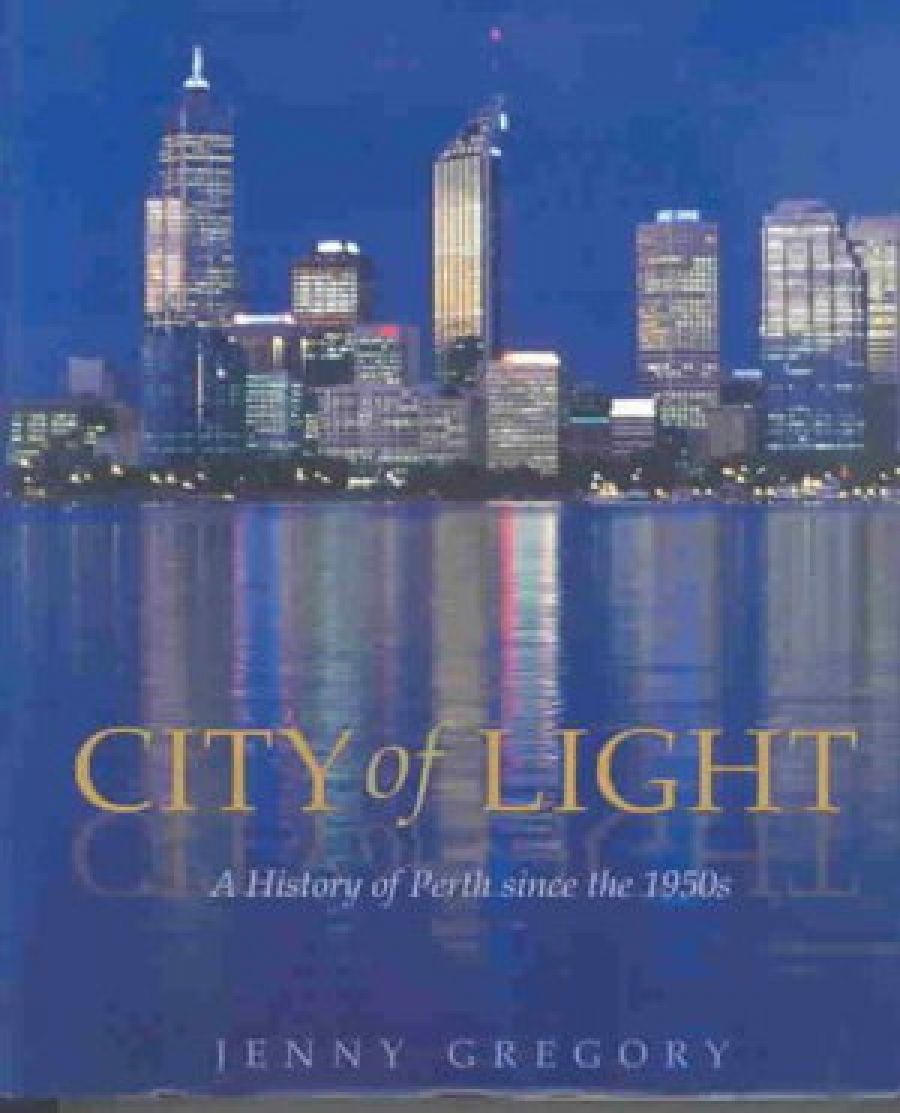
- Free Article: No
- Contents Category: Australian History
- Review Article: Yes
- Article Title: Light and Shade
- Online Only: No
- Custom Highlight Text:
Perth has been well served by its historians. C.T. Stannage’s The People of Perth (1979), a pioneering urban social history, covered the period to World War I, with a summary of developments into the 1970s. His work, because of ‘its sheer honesty did not win universal approval’. Jenny Gregory, following a lively prologue summarising the interwar years, concentrates on the period of rapid growth following World War II. She has been equally forthright. To their credit, the incumbent lord mayors welcomed the publication of both works.
- Book 1 Title: City of Light
- Book 1 Subtitle: A History of Perth Since the 1950s
- Book 1 Biblio: UWA Press, $59.95 hb, 435pp
In 1962, Perth citizens left their lights on all night to welcome the American astronaut John Glenn as he passed over the city. A journalist coined the phrase ‘a city of light’, which was adopted as an apt epithet, given the setting by the broad estuary of the Swan River, overlooked by Mt Eliza, where Sir John Forrest set aside a thousand acres to ‘enable the children of a thousand years hence to see what the bush was like when Stirling came here to found a city’. However, Gregory notes that, although ‘light is an underlying theme of this book, in both its literal and its metaphoric sense … Perth, like most cities, is not a place of enlightenment or purity, but its people have often joined together with hope for what their city might become’.
By 1954, as the city prepared for the visit of Queen Elizabeth, its population was only about 349,000 and it was the smallest of the Australian state capitals. The popular fervour for that royal tour reminds us that culturally, and in population mix, Perth was probably also the most British. At that time, there were darker places in the city, including slums and other areas blighted by industrial pollution. The most impoverished in the community were the Aboriginals. By the late 1950s, there were nearly three thousand living in the metropolitan area. From 1927, Aboriginals could not enter the city without a pass, an apartheid system that lasted until 1948. Full citizenship has not yet led to full integration. The recent redevelopment of East Perth, where Aboriginals were concentrated, has given them – as well as the rich heritage of the area – only token recognition. There has also been a longstanding dispute over the redevelopment of the Swan Brewery, the location of which includes an Aboriginal sacred site. In its earlier periods, Perth was the capital of an agricultural and pastoral state, but its first major building boom followed the gold boom of the 1890s. Perth was saved from the worst of the 1930s Depression by another gold boom. Many, if not all, of the fourteen major buildings constructed in this period would be demolished in the postwar booms, which were caused by the exploitation of other minerals, including iron, oil, nickel, bauxite and diamonds.
Perth became the fastest-growing capital, its population increasing twenty-two per cent between 1947 and 1954. There was an imperative need for both city and regional planning. A planning authority was set up in 1952 to ‘deal with the planning needs of the whole state’. Alastair Hepburn was appointed chief planner in 1952. He was joined in the following year by a consultant, Professor Gordon Stephenson, who began the inquiry that would form the basis of a plan for the whole metropolitan area.
The Stephenson–Hepburn plan was published in 1955, but eight years would elapse before the Metropolitan Region Scheme became effective. The scheme allowed relatively orderly development of the metropolitan region. However, the authors of the scheme had little interest in heritage, and did not fully recognise the importance of the connection between the city and the river when planning for the rapid increase in motor traffic. An interchange for the new Narrows Bridge led to the filling in of a large area of the river, and a freeway was built along its southern shores. Most of the buildings along St George’s Terrace were demolished and replaced by glass towers. Many regret the changed character of the city. The state did not have a Heritage Act until relatively late, although the National Trust fought to retain surviving elements of the heritage. On balance, Perth has, perhaps, been no more successful than other cities in fully achieving a balance between development and other social aspirations.
Stannage’s major theme was ‘the acquisition, maintenance, and the exercise of power and the social consequences of its distribution’. This theme continues in Gregory’s work, but the struggles became more complex, personal as well as institutional. A Metropolitan Regional Planning Authority was established, and David Carr was appointed its chief planner. At about the same time an equally talented planner, Paul Ritter, became the city planner. Unfortunately, these two men clashed, making it more difficult to reconcile the requirements of city and regional planning.
A brief review cannot do justice to a remarkable work. The author handles her material deftly, and the publishers have maintained their usual excellent standards.


Comments powered by CComment